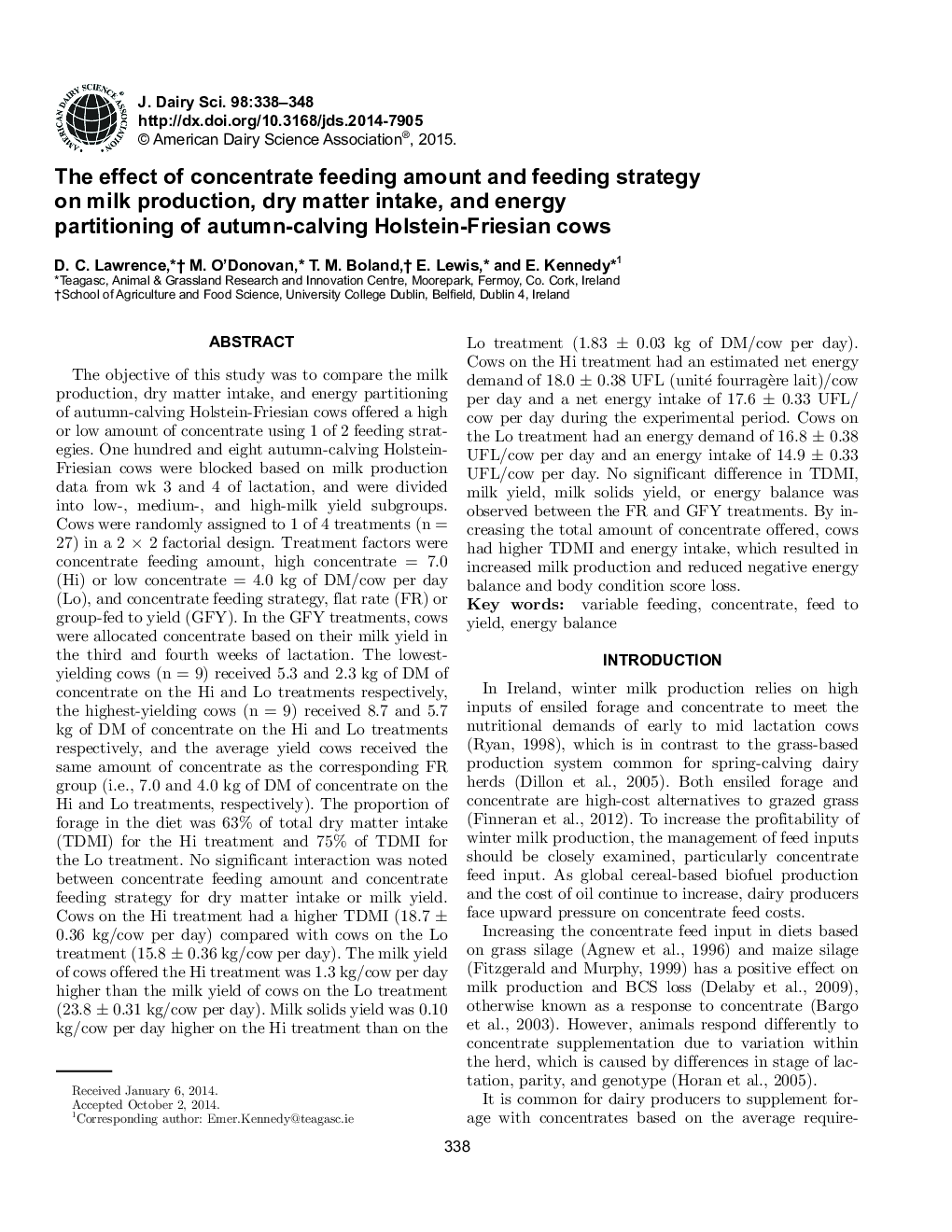| کد مقاله | کد نشریه | سال انتشار | مقاله انگلیسی | نسخه تمام متن |
|---|---|---|---|---|
| 10973815 | 1108019 | 2015 | 11 صفحه PDF | دانلود رایگان |
عنوان انگلیسی مقاله ISI
The effect of concentrate feeding amount and feeding strategy on milk production, dry matter intake, and energy partitioning of autumn-calving Holstein-Friesian cows
ترجمه فارسی عنوان
تأثیر میزان تغذیه کنسانتره و استراتژی تغذیه در تولید شیر، مصرف ماده خشک و جداسازی انرژی گاوهای هلشتاین-فریزیان پاییزی
دانلود مقاله + سفارش ترجمه
دانلود مقاله ISI انگلیسی
رایگان برای ایرانیان
کلمات کلیدی
متغیر تغذیه، تمرکز، خوراک برای عملکرد، تعادل انرژی،
موضوعات مرتبط
علوم زیستی و بیوفناوری
علوم کشاورزی و بیولوژیک
علوم دامی و جانورشناسی
چکیده انگلیسی
The objective of this study was to compare the milk production, dry matter intake, and energy partitioning of autumn-calving Holstein-Friesian cows offered a high or low amount of concentrate using 1 of 2 feeding strategies. One hundred and eight autumn-calving Holstein-Friesian cows were blocked based on milk production data from wk 3 and 4 of lactation, and were divided into low-, medium-, and high-milk yield subgroups. Cows were randomly assigned to 1 of 4 treatments (n = 27) in a 2 Ã 2 factorial design. Treatment factors were concentrate feeding amount, high concentrate = 7.0 (Hi) or low concentrate = 4.0 kg of DM/cow per day (Lo), and concentrate feeding strategy, flat rate (FR) or group-fed to yield (GFY). In the GFY treatments, cows were allocated concentrate based on their milk yield in the third and fourth weeks of lactation. The lowest-yielding cows (n = 9) received 5.3 and 2.3 kg of DM of concentrate on the Hi and Lo treatments respectively, the highest-yielding cows (n = 9) received 8.7 and 5.7 kg of DM of concentrate on the Hi and Lo treatments respectively, and the average yield cows received the same amount of concentrate as the corresponding FR group (i.e., 7.0 and 4.0 kg of DM of concentrate on the Hi and Lo treatments, respectively). The proportion of forage in the diet was 63% of total dry matter intake (TDMI) for the Hi treatment and 75% of TDMI for the Lo treatment. No significant interaction was noted between concentrate feeding amount and concentrate feeding strategy for dry matter intake or milk yield. Cows on the Hi treatment had a higher TDMI (18.7 ± 0.36 kg/cow per day) compared with cows on the Lo treatment (15.8 ± 0.36 kg/cow per day). The milk yield of cows offered the Hi treatment was 1.3 kg/cow per day higher than the milk yield of cows on the Lo treatment (23.8 ± 0.31 kg/cow per day). Milk solids yield was 0.10 kg/cow per day higher on the Hi treatment than on the Lo treatment (1.83 ± 0.03 kg of DM/cow per day). Cows on the Hi treatment had an estimated net energy demand of 18.0 ± 0.38 UFL (unité fourragère lait)/cow per day and a net energy intake of 17.6 ± 0.33 UFL/cow per day during the experimental period. Cows on the Lo treatment had an energy demand of 16.8 ± 0.38 UFL/cow per day and an energy intake of 14.9 ± 0.33 UFL/cow per day. No significant difference in TDMI, milk yield, milk solids yield, or energy balance was observed between the FR and GFY treatments. By increasing the total amount of concentrate offered, cows had higher TDMI and energy intake, which resulted in increased milk production and reduced negative energy balance and body condition score loss.
ناشر
Database: Elsevier - ScienceDirect (ساینس دایرکت)
Journal: Journal of Dairy Science - Volume 98, Issue 1, January 2015, Pages 338-348
Journal: Journal of Dairy Science - Volume 98, Issue 1, January 2015, Pages 338-348
نویسندگان
D.C. Lawrence, M. O'Donovan, T.M. Boland, E. Lewis, E. Kennedy,
